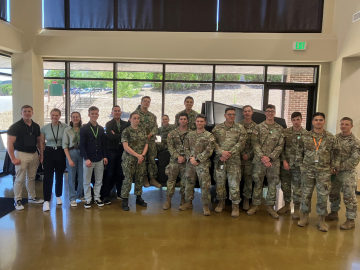
Filter News
Area of Research
- Advanced Manufacturing (8)
- Biological Systems (1)
- Biology and Environment (130)
- Biology and Soft Matter (1)
- Building Technologies (2)
- Clean Energy (146)
- Climate and Environmental Systems (6)
- Computational Biology (2)
- Computational Engineering (3)
- Computer Science (9)
- Electricity and Smart Grid (1)
- Energy Sciences (1)
- Fuel Cycle Science and Technology (2)
- Functional Materials for Energy (1)
- Fusion and Fission (29)
- Fusion Energy (11)
- Isotope Development and Production (1)
- Isotopes (11)
- Materials (71)
- Materials for Computing (12)
- Mathematics (1)
- National Security (52)
- Neutron Science (29)
- Nuclear Science and Technology (40)
- Nuclear Systems Modeling, Simulation and Validation (1)
- Quantum information Science (1)
- Supercomputing (120)
News Topics
- (-) Big Data (61)
- (-) Biomedical (61)
- (-) Climate Change (106)
- (-) Environment (201)
- (-) Frontier (45)
- (-) Machine Learning (51)
- (-) National Security (73)
- (-) Nuclear Energy (111)
- (-) Polymers (33)
- (-) Summit (59)
- (-) Sustainable Energy (130)
- (-) Transformational Challenge Reactor (7)
- 3-D Printing/Advanced Manufacturing (128)
- Advanced Reactors (34)
- Artificial Intelligence (101)
- Bioenergy (92)
- Biology (101)
- Biotechnology (24)
- Buildings (67)
- Chemical Sciences (73)
- Clean Water (31)
- Composites (30)
- Computer Science (198)
- Coronavirus (46)
- Critical Materials (29)
- Cybersecurity (35)
- Decarbonization (85)
- Education (5)
- Element Discovery (1)
- Emergency (2)
- Energy Storage (112)
- Exascale Computing (42)
- Fossil Energy (6)
- Fusion (58)
- Grid (66)
- High-Performance Computing (93)
- Hydropower (11)
- Irradiation (3)
- Isotopes (57)
- ITER (7)
- Materials (147)
- Materials Science (146)
- Mathematics (10)
- Mercury (12)
- Microelectronics (4)
- Microscopy (51)
- Molten Salt (9)
- Nanotechnology (60)
- Net Zero (14)
- Neutron Science (137)
- Partnerships (51)
- Physics (64)
- Quantum Computing (37)
- Quantum Science (72)
- Renewable Energy (2)
- Security (25)
- Simulation (52)
- Software (1)
- Space Exploration (25)
- Statistics (3)
- Transportation (99)
Media Contacts

A digital construction platform in development at Oak Ridge National Laboratory is boosting the retrofitting of building envelopes and giving builders the tools to automate the process from design to installation with the assistance of a cable-driven robotic crane.

Elton Aba, an intern at the Department of Energy’s Oak Ridge National Laboratory, collaborated with researchers to explore an intriguing intersection: how biology can inform cybersecurity. Aba shared some of his findings on how biomimicry could help secure our nation’s critical infrastructure.

Mohamad Zineddin, a distinguished researcher in nuclear and radiological engineering, recently received the Roger Howsley Award for Excellence in Nuclear Security.

Researchers at ORNL are using satellite images of homes under construction to address gaps in census data, especially in areas like Sub-Saharan Africa. By analyzing these images, they estimate dwelling sizes and population densities where traditional data is sparse. This method improves population estimates and supports national security by enhancing emergency response capabilities.

Jeremiah Sewell leads a team at ORNL, working on xenon-129 production for lung imaging. Reflecting on his career, Sewell views each opportunity as a "door" he steps through, leveraging over 25 years of experience in nuclear power and centrifuge operations to advance the facility’s mission.

Debjani Singh, a senior scientist at ORNL, leads the HydroSource project, which enhances hydropower research by making water data more accessible and useful. With a background in water resources, data science, and earth science, Singh applies innovative tools like AI to advance research. Her career, shaped by her early exposure to science in India, focuses on bridging research with practical applications.

A study found that beaches with manmade fortifications recover more slowly from hurricanes than natural beaches, losing more sand and vegetation. The researchers used satellite images and light detection and ranging data, or LIDAR, to measure elevation changes and vegetation coverage. Changes in elevation showed how much sand was depleted during the storm and how much sand returned throughout the following year.

Researchers at ORNL have demonstrated that small molecular tweaks to surfaces can improve absorption technology for direct air capture of carbon dioxide. The team added a charged polymer layer to an amino acid solution, and then, through spectroscopy and simulation, found that the charged layer can hold amino acids at its surface.

Benjamin Manard, an analytical chemist in the Chemical Sciences Division of the Department of Energy’s Oak Ridge National Laboratory, will receive the 2024 Lester W. Strock Award from the Society of Applied Spectroscopy.

Ten future U.S. Army officers recently visited ORNL to learn about the legacy of nuclear science. As students of the Nuclear Science and Engineering Research Center, or NSERC, with the Defense Threat Reduction Agency, or DTRA, they stopped in East Tennessee as part of a larger tour across nuclear facilities supporting the military. In Oak Ridge, they visited ORNL to gain an appreciation of the history of the Manhattan Project and how research at a national lab contributes new materials and electronics for the nuclear industry.


